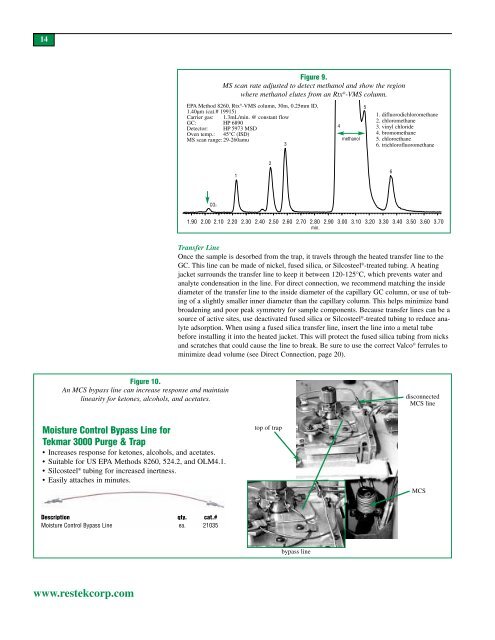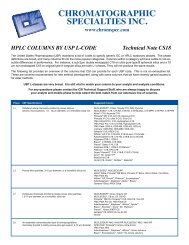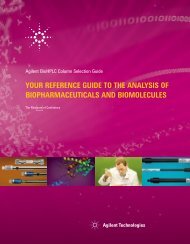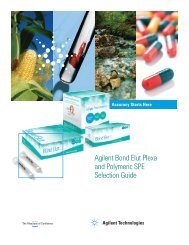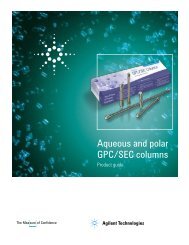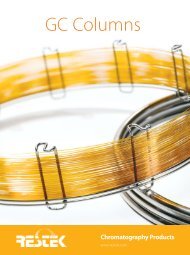Optimizing the Analysis of Volatile Organic Compounds
Optimizing the Analysis of Volatile Organic Compounds
Optimizing the Analysis of Volatile Organic Compounds
Create successful ePaper yourself
Turn your PDF publications into a flip-book with our unique Google optimized e-Paper software.
14<br />
Figure 10.<br />
An MCS bypass line can increase response and maintain<br />
linearity for ketones, alcohols, and acetates.<br />
Moisture Control Bypass Line for<br />
Tekmar 3000 Purge & Trap<br />
Increases response for ketones, alcohols, and acetates.<br />
Suitable for US EPA Methods 8260, 524.2, and OLM4.1.<br />
Silcosteel ® tubing for increased inertness.<br />
Easily attaches in minutes.<br />
Description qty. cat.#<br />
Moisture Control Bypass Line ea. 21035<br />
www.restekcorp.com<br />
Figure 9.<br />
MS scan rate adjusted to detect methanol and show <strong>the</strong> region<br />
where methanol elutes from an Rtx ® -VMS column.<br />
EPA Method 8260, Rtx<br />
3<br />
® -VMS column, 30m, 0.25mm ID,<br />
1.40µm (cat.# 19915)<br />
Carrier gas: 1.3mL/min. @ constant flow<br />
GC: HP 6890<br />
Detector: HP 5973 MSD<br />
Oven temp.: 45°C (ISD)<br />
MS scan range: 29-260amu<br />
CO2<br />
1<br />
2<br />
Transfer Line<br />
Once <strong>the</strong> sample is desorbed from <strong>the</strong> trap, it travels through <strong>the</strong> heated transfer line to <strong>the</strong><br />
GC. This line can be made <strong>of</strong> nickel, fused silica, or Silcosteel ® -treated tubing. A heating<br />
jacket surrounds <strong>the</strong> transfer line to keep it between 120-125°C, which prevents water and<br />
analyte condensation in <strong>the</strong> line. For direct connection, we recommend matching <strong>the</strong> inside<br />
diameter <strong>of</strong> <strong>the</strong> transfer line to <strong>the</strong> inside diameter <strong>of</strong> <strong>the</strong> capillary GC column, or use <strong>of</strong> tubing<br />
<strong>of</strong> a slightly smaller inner diameter than <strong>the</strong> capillary column. This helps minimize band<br />
broadening and poor peak symmetry for sample components. Because transfer lines can be a<br />
source <strong>of</strong> active sites, use deactivated fused silica or Silcosteel ® -treated tubing to reduce analyte<br />
adsorption. When using a fused silica transfer line, insert <strong>the</strong> line into a metal tube<br />
before installing it into <strong>the</strong> heated jacket. This will protect <strong>the</strong> fused silica tubing from nicks<br />
and scratches that could cause <strong>the</strong> line to break. Be sure to use <strong>the</strong> correct Valco ® ferrules to<br />
minimize dead volume (see Direct Connection, page 20).<br />
top <strong>of</strong> trap<br />
4<br />
methanol<br />
5<br />
1. difluorodichloromethane<br />
2. chloromethane<br />
3. vinyl chloride<br />
4. bromomethane<br />
5. chloroethane<br />
6. trichlor<strong>of</strong>luoromethane<br />
1.90 2.00 2.10 2.20 2.30 2.40 2.50 2.60 2.70 2.80 2.90 3.00 3.10 3.20 3.30 3.40 3.50 3.60 3.70<br />
1.90 2.00 2.10 2.20 2.30 2.40 2.50 2.60 2.70 2.80 2.90 3.00 3.10 3.20 3.30 3.40 3.50 3.60 3.70<br />
min.<br />
bypass line<br />
6<br />
disconnected<br />
MCS line<br />
MCS


